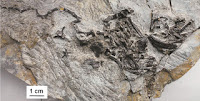Australia has a diverse
assemblage of Sea Turtles today, with six of the seven living Sea
Turtle species found in Australian waters and one found nowhere else.
The continent also has an extensive fossil record of Cretaceous
Turtles, but no post-Cretaceous fossil Turtles have been found in
Australia to date. This is odd, as Turtles have excellent
preservational potential, having dense bony shells and spending much
of their lives in shallow marine environments, and because Cainozoic
fossil Turtles are known from New Guinea and New Zealand, making it
highly unlikely that Sea Turtles were absent from Australia during
this time.
In a paper published in
the journal Alcheringa on 16 October 2014, Erich Fitzgerald and
Lesley Kool of Geosciences at Museum Victoria describe the discovery
of fragmentary Turtle remains from the Late Miocene to Early Pliocene
Black Rock Sandstone at Beaumaris on Port Philip Bay in Victoria
State, Australia.
The Black Rock formation
is noted for a diverse vertebrate assemblage, including Sharks and
Rays, Bony Fish, Penguins, other Seabirds, Sireneans, Seals, Baleen
and Toothed Whales, and some terrestrial Birds and Marsupials, as
well as invertebrates such as Molluscs and Echinoderms and
microfossils such as Foraminiferans.
Only two Turtle bones
were recovered from the site, an almost complete dentary (lower
jawbone) and the proximal tip of a costal bone (plate on the dorsal portion of the shell derived from a modified rib). This is not
enough to assign the remains to any particular Turtle, though they do
resemble other specimens assigned to the genus Pacifichelys,
which has previously been described from California and Peru.
Isolated
proximal end of a costal of an unidentified Turtle in: (A, dorsal;
(B) visceral; and (C) proximal views. Specimen whitened with ammonium
chloride. Fitzgerald & Kool (2014).
See also...
 Turtle eggs from the Late Cretaceous of Madagascar. Turtles are
unique among living Amniotes (Vertebrates that can lay...
Turtle eggs from the Late Cretaceous of Madagascar. Turtles are
unique among living Amniotes (Vertebrates that can lay... Pappochelys rosinae: A Proto-Turtle from the Middle Triassic of Badem Württemberg, Germany. Turtles
have a fairly good fossil record, as would...
Pappochelys rosinae: A Proto-Turtle from the Middle Triassic of Badem Württemberg, Germany. Turtles
have a fairly good fossil record, as would... Desmatochelys padillai: A Protostegid Turtle from the Early Cretaceous of Colombia. The
Protostegid Turtles were a group of Turtles known from the Cretaceous
that are thought to have been members of the Chelonioidea, the group
that includes the two living Marine Turtle groups, the Chelonidoidea
(Sea Turtles) and Dermochelyidae (Leatherback...
Desmatochelys padillai: A Protostegid Turtle from the Early Cretaceous of Colombia. The
Protostegid Turtles were a group of Turtles known from the Cretaceous
that are thought to have been members of the Chelonioidea, the group
that includes the two living Marine Turtle groups, the Chelonidoidea
(Sea Turtles) and Dermochelyidae (Leatherback...
Follow
Sciency Thoughts on Facebook.

